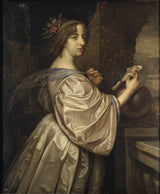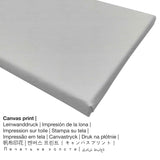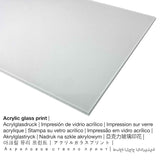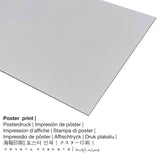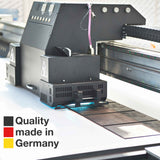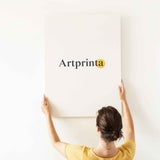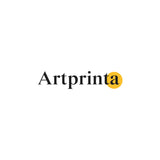David Beck, 1650 - Queen Christina nke Sweden (1626 - 1689) - mbipụta nka mara mma.
Ụtụ gụnyere. Mbupu gbakọrọ na ndenye ọpụpụ.
What specifically does the original description of the Nationalmuseum Stockholm state about this 17th century artwork painted by David Beck? (© - nke Nationalmuseum Stockholm - www.nationalmuseum.se)
English: Christina ruled over an expansive superpower. There are several details in this portrait of her that point to interests far beyond Sweden’s borders: the shimmering silk, the citrus blossoms in her hair, and the idealized landscape that fades away in the distance. The rich folds of the dress, the elegant turn of the body, and the sense of capturing the fleeting moment—she is just looking up from reading a letter—were highly fashionable elements in portraiture at the time. The artist was, after all, trained in London by Anthony van Dyck, the leading portraitist of the Baroque. Kristina regerade över en expansiv stormakt. I porträttet av henne finns flera detaljer som pekar på intressen långt utanför Sveriges gränser: det glänsande sidentyget, citrusblommorna i håret och ideallandskapet som tonar bort i fjärran. Klädernas rika veck, den eleganta kroppsvridningen och ögonblickskaraktären – hon tittar just upp från läsningen av ett brev – var högsta mode inom porträttkonsten. Så var också konstnären skolad i London hos Anthonis van Dyck, barockens ledande porträttmålare.
Iberibe ozi ndabere nka
| Aha ọrụ nka: | "Queen Christina of Sweden (1626 - 1689)" |
| Nhazi: | sere |
| Okwu mkpokọta: | nka ochie |
| oge: | 17th narị afọ |
| Afọ nka: | 1650 |
| Afọ nka: | karịa afọ 370 |
| Akụkụ nke nka nka izizi: | Ogologo: 110 cm (43,3 ″); Obosara: 92 cm (36,2 ″) Ekebere: Elu: 129 cm (50,7 ″); Obosara: 111 cm (43,7 ″); Omimi: 10 cm (3,9 ″) |
| Egosiputara na: | National Museum nke Stockholm |
| Ebe ngosi nka: | Stockholm, Obodo Stockholm, Sweden |
| Ụlọ ihe ngosi nka webụsaịtị: | National Museum nke Stockholm |
| Ụdị nka nka: | ngalaba ọha |
| Site n'aka: | Nationalmuseum Stockholm na Wikimedia Commons |
Banyere omenka
| Aha onye nka: | David Beck |
| Obodo onye nka: | Dutch |
| Ọrụ: | onye na-ese ihe |
| Country: | mba netherland |
| Otu nka: | nna ukwu ochie |
| Afọ ọnwụ: | 35 afọ |
| Amụrụ n'afọ: | 1621 |
| Obodo amụrụ: | Delft |
| Afọ ọnwụ: | 1656 |
| Obodo ọnwụ: | The Hague |
Banyere ngwaahịa
| Nkewa bipụta: | ọrụ mgbidi |
| Mmeputakwa: | dijitalụ mmeputakwa |
| Usoro mmepụta: | mbipụta dijitalụ (Mbipụta UV ozugbo) |
| Nlụpụta: | arụpụtara na Germany |
| Ụdị ngwaahịa: | a na-achọ |
| Eji ngwaahịa a chọrọ: | mgbidi gallery, foto mgbidi |
| Nhazi: | nhazi ihe osise |
| Ụdị anya: | ogologo: obosara 1:1.2 |
| Oke onyonyo pụtara: | ogologo bụ 20% mkpụmkpụ karịa obosara |
| Nhọrọ akwa: | Mbipụta kwaaji, mbipụta enyo acrylic (nwere ezigbo mkpuchi iko), mbipụta ọla (aluminium dibond), mbipụta akwụkwọ mmado (akwụkwọ kwaaji) |
| Kanvas n'elu etiti ihe ndọtị (mbipụta akwa akwa): | 50x60cm - 20x24", 100x120cm - 39x47", 150x180cm - 59x71" |
| Mpempe iko acrylic (nwere ezigbo mkpuchi iko) nha dị iche iche: | 50x60cm - 20x24", 100x120cm - 39x47", 150x180cm - 59x71" |
| Mbipụta akwụkwọ mmado (akwụkwọ kwaaji): | 50x60cm - 20x24", 100x120cm - 39x47" |
| Mpempe akwụkwọ Dibony (ihe alumnium) nha: | 50x60cm - 20x24", 100x120cm - 39x47" |
| Igwe onyonyo: | biko buru n'uche na edeghị nka nka |
Họrọ ihe kacha amasị gị
Maka ngwaahịa ọ bụla anyị na-enye ihe dị iche iche dị iche iche na nha. Họrọ n'ime nhọrọ ngwaahịa ndị a ugbu a ka ị kwekọọ na mmasị gị na nha na akụrụngwa:
- Mbipụta kanvas: The canvas direct print is a printed canvas stretched on a wooden frame. Additionally, a printed canvas creates a cosy and warm effect. A printed canvas of this masterpiece will provide you with the chance to transform your fine art print into a large size artwork. How can I hang a canvas print on the wall? A canvas print has the advantage of being relatively low in weight, which means that it is easy to hang the Canvas print without additional wall-mounts. Canvas prints are suitable for any kind of wall.
- Mbipụta aluminom (aluminium dibbond): This is a metal print made on aluminium dibond material with an impressive depth. Colors are luminous in the highest definition, the fine details of the print appear clear and crisp, and the print has a a matte look that you can literally feel.
- Akwụkwọ mmado ebipụtara (akwa akwa akwa): The Artprinta poster is a printed flat canvas with a fine surface structure. Please note, that depending on the size of the poster we add a white margin 2-6 cm around the print, which facilitates the framing with your custom frame.
- Bipụta na iko acrylic (nke nwere ezigbo mkpuchi iko): A glossy print on acrylic glass, often referenced as a print on plexiglass, will convert your favorite original into great décor. Besides, it is a great alternative to aluminium and canvas prints. The artwork is being custom-made with modern UV direct print machines. The major upside of an acrylic glass print is that sharp contrasts and smaller image details become visible thanks to the precise tonal gradation. The real glass coating protects your custom art replica against light and external influences for many years.
Nchịkọta nke ọrụ nka karịrị afọ 370
N’afọ 1650 David Beck created the painting. The 370 years old version of the work of art measures the size: Ogologo: 110 cm (43,3 ″); Obosara: 92 cm (36,2 ″) Ekebere: Elu: 129 cm (50,7 ″); Obosara: 111 cm (43,7 ″); Omimi: 10 cm (3,9 ″). Today, this artpiece belongs to the Nationalmuseum Stockholm's digital art collection, which is Sweden's museum of art and design, a Swedish government authority with a mandatet o preserve cultural heritage and promote art, interest in art and knowledge of art. We are delighted to reference that this public domain work of art is being provided with courtesy of Nationalmuseum Stockholm na Wikimedia Commons.Moreover, the artwork has the creditline: . In addition to this, the alignment is in portrait format na a akụkụ ruru nke 1: 1.2, nke pụtara na ogologo bụ 20% mkpụmkpụ karịa obosara.
Disclaimer: We try everythig possible in order to describe the products as clearly as possible and to exhibit them visually on the respective product detail pages. Although, the pigments of the print materials, as well as the print result may diverge slightly from the representation on the monitor. Depending on the screen settings and the nature of the surface, colors can unfortunately not be printed one hundret percent realistically. In view of the fact that all the fine art prints are processed and printed by hand, there might as well be slight discrepancies in the exact position and the size of the motif.
© Nwebiisinka nke - Artprinta.com

